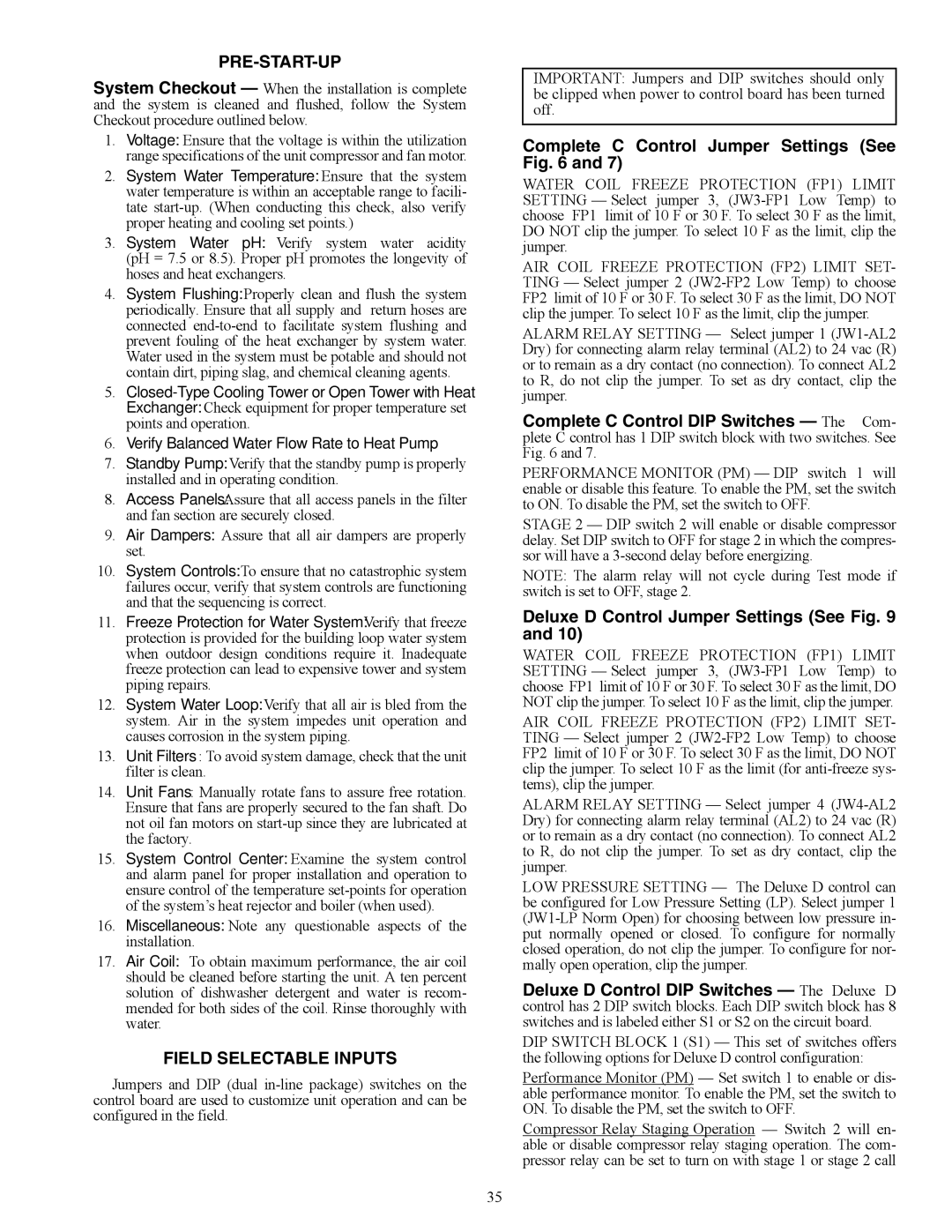PRE-START-UP
System Checkout — When the installation is complete and the system is cleaned and flushed, follow the System Checkout procedure outlined below.
1.Voltage: Ensure that the voltage is within the utilization range specifications of the unit compressor and fan motor.
2.System Water Temperature: Ensure that the system water temperature is within an acceptable range to facili- tate
3.System Water pH: Verify system water acidity (pH = 7.5 or 8.5). Proper pH promotes the longevity of hoses and heat exchangers.
4.System Flushing: Properly clean and flush the system periodically. Ensure that all supply and return hoses are connected
5.
6.Verify Balanced Water Flow Rate to Heat Pump.
7.Standby Pump: Verify that the standby pump is properly installed and in operating condition.
8.Access Panels: Assure that all access panels in the filter and fan section are securely closed.
9.Air Dampers: Assure that all air dampers are properly set.
10.System Controls: To ensure that no catastrophic system failures occur, verify that system controls are functioning and that the sequencing is correct.
11.Freeze Protection for Water System: Verify that freeze protection is provided for the building loop water system when outdoor design conditions require it. Inadequate freeze protection can lead to expensive tower and system piping repairs.
12.System Water Loop: Verify that all air is bled from the system. Air in the system impedes unit operation and causes corrosion in the system piping.
13.Unit Filters: To avoid system damage, check that the unit filter is clean.
14.Unit Fans: Manually rotate fans to assure free rotation. Ensure that fans are properly secured to the fan shaft. Do not oil fan motors on
15.System Control Center: Examine the system control and alarm panel for proper installation and operation to ensure control of the temperature
16.Miscellaneous: Note any questionable aspects of the installation.
17.Air Coil: To obtain maximum performance, the air coil should be cleaned before starting the unit. A ten percent solution of dishwasher detergent and water is recom- mended for both sides of the coil. Rinse thoroughly with water.
FIELD SELECTABLE INPUTS
Jumpers and DIP (dual
IMPORTANT: Jumpers and DIP switches should only be clipped when power to control board has been turned off.
Complete C Control Jumper Settings (See Fig. 6 and 7)
WATER COIL FREEZE PROTECTION (FP1) LIMIT SETTING — Select jumper 3,
AIR COIL FREEZE PROTECTION (FP2) LIMIT SET- TING — Select jumper 2
ALARM RELAY SETTING — Select jumper 1
Complete C Control DIP Switches — The Com- plete C control has 1 DIP switch block with two switches. See Fig. 6 and 7.
PERFORMANCE MONITOR (PM) — DIP switch 1 will enable or disable this feature. To enable the PM, set the switch to ON. To disable the PM, set the switch to OFF.
STAGE 2 — DIP switch 2 will enable or disable compressor delay. Set DIP switch to OFF for stage 2 in which the compres- sor will have a
NOTE: The alarm relay will not cycle during Test mode if switch is set to OFF, stage 2.
Deluxe D Control Jumper Settings (See Fig. 9 and 10)
WATER COIL FREEZE PROTECTION (FP1) LIMIT SETTING — Select jumper 3,
AIR COIL FREEZE PROTECTION (FP2) LIMIT SET- TING — Select jumper 2
ALARM RELAY SETTING — Select jumper 4
LOW PRESSURE SETTING — The Deluxe D control can be configured for Low Pressure Setting (LP). Select jumper 1
Deluxe D Control DIP Switches — The Deluxe D control has 2 DIP switch blocks. Each DIP switch block has 8 switches and is labeled either S1 or S2 on the circuit board.
DIP SWITCH BLOCK 1 (S1) — This set of switches offers the following options for Deluxe D control configuration: Performance Monitor (PM) — Set switch 1 to enable or dis- able performance monitor. To enable the PM, set the switch to ON. To disable the PM, set the switch to OFF.
Compressor Relay Staging Operation — Switch 2 will en- able or disable compressor relay staging operation. The com- pressor relay can be set to turn on with stage 1 or stage 2 call
35
